
| > Back to main RAILWAY STAMPS page < |  CJRRU |
> Forward to next page of this exhibit < |
netherlands |
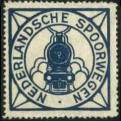
Railway Parcel and Letter Stamps of Netherlands, 1914- 1979
_____________________________________________
1914-1944
All the Dutch railway stamps from 1914 to 1944 are of the same basic design, with different inscriptions at the bottom, different over-prints, variations in the details of the other elements, and different colors. There were many printings, and different styles of lettering for the overprints. Four of at least eleven distinct types are shown above.
Other issues of this period have these inscriptions at the bottom:
Ooster Stoomtram Mij = Eastern Steamtram company
Ned. Buurtspoorweg Mij = Dutch Local Railway Company
_____________________________________________
1946-1979
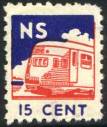
1946 |

1964 |

1965 |
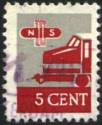
1966 |
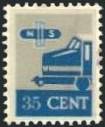
1966 |
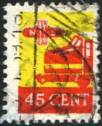
1967 |

1972 |

1972 |
From 1946 to 1979 these more modern designs were used.
I asked Hans Vink of the Netherlands ( Visit his website about rail stamps of Netherlands) how these stamps were issued and used -
Were all of these just for letters? Or were they valid on parcels as well?
Originally they were meant for parcels up to 6 Guilders. They were pasted on freight letters (bills of lading or waybills). There were two types: one for railway stations and one for dispatch services. (Different colours, see website)
From 1924 onwards only the 5 and 10 cents stamps were also used for train letters (1924-1927 only express letters). The rate was 10 cents. They had to be put on the back of the envelope. That's why they are not in the official catalogues. I don't consider these as cinderellas. Several letters are known with these stamps on the front. They were only for letters handed in at railway stations and were used for postal delivery.
1/12/5 - Bill Weinberger wrote to add the following:
Letter stamps-- The low values of the old Netherlands parcel stamps were also sanctioned by the government to affix to letters-- In fact streetcars carried mailboxes that were emptied at post offices for this extra fee-- I once had a number of these envelopes and seem to remember the 15c-- so it appears ALL the modern issues are Letter stamps.
1/14/5 - Hans Vink added this:
From 1-4-1924 until the railway strike in Sept. 1944 letters could be sent by rail at a rate of 10c. Therefore the 5 and 10 cents railway parcel stamps were to be used. The stamp had to be stuck on the back of the envelope.
From 1-5-1946 express letters only could be sent by rail again, now costing 15c. (new design).
On 7-10-1951 it was possible again to send private letters by rail. The same 15c. stamps had to be used. This time stuck on the front of the envelope.
Also all the later designs (and values) are indeed (railway) letter stamps.
Is a "freight letter" the same as a bill of lading or a waybill, i.e. a form that serves as a receipt or accompanies a parcel?
A waybill, I suppose (see image below)
What is a "dispatch service"?
They were private companies that took care of the transportation and the delivery of parcels and the like. They were situated near shunting-yards. The best-known was "Van Gend en Loos." So they made use of the rail system, but had vans as well for local delivery.
You say the stamps were sometimes used for "letters handed in at railway stations and were used for postal delivery." How did these letters travel?
Train letters were given to a railway official at the station who stuck the railway stamp on the envelope. So this was not done by the customer. The letter was boarded on the first train that would leave (in the right direction). On arrival the letter was handed over to the postal service, which would take care of normal delivery.
You do not show an example of the first issue - 1914-1920. Was its design the same as the next issue (1917-20)?
The designs for the stamps were all the same till 1944. This design was taken from this plaque over the entrance to 1st class waiting room of Haarlem station:
Tell me more about how the various issues up to 1944 differ.
The differences between the issues are:
A. the fonts used by different printing firms
B. the different railway companies of course
C. the colours:- Nederlandsche Staatsspoorwegen (=Dutch State Railways): yellow/orange (stations) and red (dispatch services)D. the perforations
- Hollandsche IJzeren Spoorweg Maatschappij (=Dutch Iron Railway Company): purple/violet (stations) and green (dispatch services)
- Nederlandsche Spoorwegen (=Dutch Railways): yellow/orange (stations) and red (dispatch services)
You list an issue for 1934-1944, then the next one (in the modern style) is 1946. Was there no letter service from 1944 to 1946?
That's right. After the railway strike in 1944 - resistance against the German oppressor - there were no postal train services until 1946.
Speaking of the early issues again - were the stamps issued by several different railroads at the same time?
Ooster Stoomtram Mij. and Ned. Buurtspoorweg mij. used the stamps of Nederlandsche Spoorwegen and over-printed their own names on them. The former had the name either on top or at the bottom, the latter only at the bottom
Was the design on the stamps officially dictated, i.e. all were required to use the same design?
"That's a good question," as people say when they don't know the answer. As far as I know, the design was not dictated. Printing firm Joh. Enschedé, one of the firms that used to produce these stamps, tried to find out who the original designer was but didn't succeed. It is remarkable though, that all the companies (even in the years that they were independent, i.e. before the mergers) and the different printing firms used the same design. I really don't know why.
Thanks, Hans.
On another web site I learned this about rail system in Netherlands:
It seems that you can reach about any place in Holland by train. The Dutch Railways consist of a network of some 2600km, of which 2000km is electrified with 1500V= overhead wire. On the Dutch Railways you can find about 140 electric locomotives, 125 diesel locomotives, 100 diesel shunters, 500 EMUs and 150 DMUs. The trains cross the country in all directions and not a moment goes by that you don't see a train on its appointed route.
__________________________________________________
IMPORTANT NOTE: This page is a work-in-progress, subject to revision
as I learn more.
If you find errors, please let me know, so I can correct them. Send to  .
.
| > Back to main RAILWAY STAMPS page < |  CJRRU |
> Forward to next page of this exhibit < |
Send feedback to the author: CLICK HERE
Created -- 12/08/2004
Revised -- 01/14/2005